Club Fitting for Pinheads
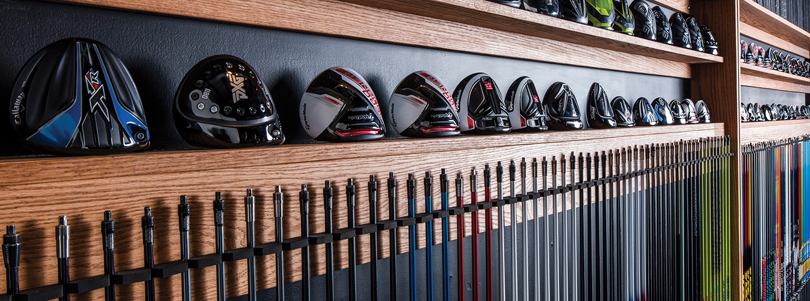
These days, every golfer is a gear head. We all have at least one adjustable club in our bag (and most of us have at least two, if not three or four), and can be seen tinkering, tweaking and fiddling with the adjustable components, trying to “dial in” the driver to gain that extra 5-10 yards. Behind all the gear talk and driver manipulation is a true tinkering revolution that has been swiftly building over the last 6-8 years – custom club fitting.
We aren’t talking about your basic, run of the mill “hit a few balls and see how this feels and then buy the set we have in stock” shakedown that dominated the club buying landscape for decades; we are talking about the geeked-out, launch monitor-obsessed, dial in your spin rate in a 3-hour long session master club fitters that are rising up as gods (and maybe saviors?) in the golf industry.
Now, the idea of club fitting isn’t a new one, in so far as golfers of all levels have always been looking for the right combination of head and shaft to help them hit the golf ball farther and straighter, but it wasn’t until the last 30 years or so that things started to pick up in the club fitting industry. In the early 1980s, club manufacturer PING set the stage for iron fitting by introducing their color-coded dot system, building clubs with different lie angles to better fit individual swings. Then, toward the end of the 80s, another company came along – Henry-Griffitts – with a system for club fitting that was decades before its time.
“I remember when the Henry-Griffitts cart system came in, probably in the late 1980s, and it was this giant cart with all these club heads with different lie angles,” said Art Sellinger, founder of Sellinger’s Power Golf, and one of the most respected clubfitters in the area. “You could extract one head from the shaft and screw on another one … it was so far ahead of its time, I’m not even sure if they realized how incredible they system was.”
The introduction of the fitting cart certainly helped club fitting take a nice jump forward, but the ’90s were a static time for advancement. Metal drivers were just starting to become popular – helped in large part by the introduction of the Callaway Big Bertha in 1991 – and most people were still using steel shafts in all their woods.
Now, more than 25 years later, the club fitting industry has exploded. Not only do you have adjustable drivers (which debuted with the TaylorMade r7 Quad in 2004), but players of any level have every shaft combination in the world readily available to them and installed with just a few turns of a wrench. And on top of that, revolutionary Doppler technology, invented to track enemy missiles, powers the industry’s popular launch monitors – such as TrackMan and FlightScope – that give players all the possible data they could ever ask for.
The world of club fitting is big and impressive, but can also be overwhelming. Don’t worry, we at AVIDGOLFER have got your back. We spoke with some of the leading club fitting experts in the Metroplex about all the basics you need to know about club fitting.
8 BASIC TERMS EVERY GOLFER NEEDS TO KNOW
- Shaft Flex • In its simplest terms, shaft flex is defined as how much the shaft bends when force (aka your swing) is applied to the clubhead. The faster you swing the club, the more a shaft will bend. Thus, shaft makers design shafts of different “stiffness” (R, S, XL, etc.) to allow players to find the proper amount of bend in the shaft for their swing.
- Loft • Loft is the angle formed between the clubface and the shaft when a club is set at address. Drivers, woods and lower-numbered clubs have “less” loft (a driver typically has between 7 and 12 degrees of loft), and higher-numbered clubs and wedges have “more” loft. Typically, the higher the loft, the easier it will be to get the ball up into the air.
- Lie • The “lie angle” of a club is the angle between the shaft and the bottom of the club, when the club is soled flat on the ground. If your club has a proper “lie angle” for your swing, then the sole of the club is perfectly parallel to the ground at impact. If the toe or heel of the club is not parallel to the ground at impact, accuracy can be affected.
- Clubhead Speed • Clubhead (or just “club”) speed is the speed the clubhead is traveling immediately prior to impact. More club speed equals more potential distance, but other factors (spin rate, ball speed, etc.) can affect distance as well.
- Ball Speed • Ball speed is the speed of the golf ball immediately after impact. While clubhead speed is key to potential distance, ball speed is the biggest factor in how far the ball actually travels.
- Spin Rate • The rate (revolutions per minute) the golf ball spins immediately after impact. Spin rate is an important number in determining height and distance, as (in general), the more spin the golf ball has, the higher it will go and the shorter it will travel.
- Bounce • Bounce is the angle between the ground and the sole of the club at address, and is most associated with wedges. The more “bounce” a club has, the less the leading edge will “dig” into the turf at impact. More bounce is often applied to high-lofted wedges to that the club does not dig into rough or sand at impact.
- Swing Weight • Swing weight is the measurement of how the weight of a club feels when swung, not the overall weight of the club. Swing weight can vary greatly according to where the weight is in the club – adding weight to the clubhead vs. the shaft can change the swing weight in different ways, while changing the actual weight the same way. Having consistent swing weights throughout your set is critical to consistency.
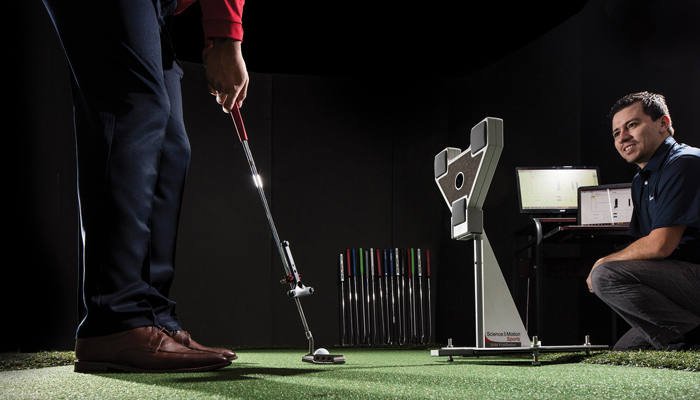
INTRO TO THE FITTING EXPERIENCE
Nick Sherburne • Club Champion
For a true club fitter, the approach doesn’t change if the player is a high handicapper or a low handicapper. The experience is the same, because the goal is the same – better equipment, better scores and lower handicaps. Best fitting starts with learning about the player. Who they are, what they like, what their strengths and weaknesses are, what the temperament is, attitude, goals, etc. You can’t do a proper fitting without getting to know the person.
A proper fitting shouldn’t be a lesson – PGA instructors change the swing, club fitters help a player find the best equipment to fit the swing. The club fitter needs to have deep knowledge of the golf swing to understand what is happening and best fit the player, but our goal isn’t to be instructors.
On working with different skill levels … For a player shooting in the 90s or 100s, distance and accuracy are the most important facts and we can often make a large impact there the quickest by getting them the correct equipment. For a better player (single digit or scratch), we are usually honing in on a few details, tightening lose ends throughout the set or targeting small result changes.
TrackMan data and numbers are great, and it is important for players to understand what those numbers mean, but we don’t let them get overwhelmed or blinded by the numbers. A club fitting should make improvements in the individual’s game, not be a vehicle to achieve certain numbers. Those numbers may not be best for that player to begin with.
The goal is to achieve the best numbers for you, not some incorrectly perceived notion of what the best numbers should be. If Dustin Johnson spins his driver at 1900 rpm, is that the standard every amateur golfer should strive for? No, because that number may not maximize distance for someone who swings the club 90 mph.
Fittings inside versus outside … Fitting done inside is much more beneficial than one outdoors. We can control all the elements inside, and take the visual focus off ball flight to prevent the client from making swing changes to alter ball flight. BUT, if fitting is to be done inside, we have to have the proper equipment and technology to match outdoor results. A properly equipped fitting expert should be able to match almost exactly the results in the hitting bay to what they will be on the golf course.
The taboo subject of the putter fitting … Don’t forget about your putter – it is responsible for 40 percent of your score, so why would you use a putter that isn’t right for you? Most quality fitters have the necessary equipment, such as a SAM PuttLab, to get find a putter that fits not only your eye, but your style of putting stroke. Most people who initially shrug off the idea, believing their putter is fine (or that a new one couldn’t make much of a difference), are amazed with the data and the on-course results after just a few minutes in the PuttLab.
To me, two things are most important in putter fitting:
- Weight – the weight of the putter head affects your speed control and speed consistency
- Toe Hang – You want your putter to have the proper amount of toe hang to match your stroke path. If you putt with a fairly straight-back, straight-through stroke path, you’ll want a putter with little or no toe hang. If your stroke path has a good amount of arc, you’ll want more toe hang in your putter.
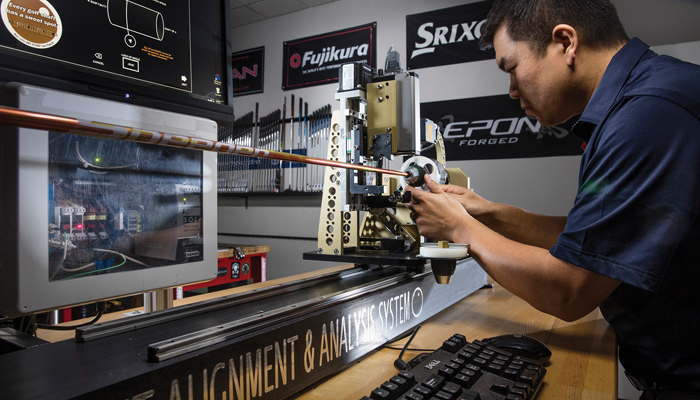
WHAT YOU NEED TO KNOW ABOUT SHAFTS
Ryan Tolentino • Cool Clubs
The shaft is the single most important component of the golf club, and having a shaft that truly fits your swing is paramount to consistent shots. If the club head is the engine, the shaft is the transmission. If the transmission is no good, the engine won’t work like it should.
Kick point is the spot in the shaft where most of the shaft bending takes place during the swing. Kick point, in general, has an inverse relationship to ball flight. The lower the kick point (closer to the club head), the higher the ball flight.
On the irrelevancy of “R,” “S” and “X” … There is no industry standard for flex, thus the terms “regular” or “stiff” or “extra stiff” mean almost nothing for club fitters. Shaft manufacturers continue to use them for ease of selection at retail chains for consumers, but terms are becoming obsolete, because one shaft company’s “stiff” may be another’s “regular.” Frequency is the best measure of the flex of a shaft; shaft frequency is a number that can be tested and calculated, thus can be applied more universally across different model shafts. If two shafts from different makers both have a frequency of 275 cpm (cycles per minute), you can bet their stiffness is very similar. The higher the frequency, the stiffer the shaft.
Golfers need to understand frequency and accept the fact that what letter (R, S, X) that is printed on a shaft is completely irrelevant. Most fitters can build a “regular” shaft into x-stiff, or vice versa. It all depends on how the specific shaft has been designed, how we cut it, length, weight, etc. Don’t let your ego get in the way of what works best of you.
On self-diagnosing a shaft issue … How do you know if your shaft isn’t the right flex? Get fitted! But, in general, you can tell by ball flight and consistency. If your ball tends to fly overly high or you can’t consistency control it, your shaft may not be stiff enough.
The weight of a shaft is important to player preference on how it feels. Shaft technology is trending toward super-light shafts that still keep spin down. Great for older players with much slower swing speeds who need a super-light shaft.
There is no universal brand of shaft that is right for everyone. Every club fitter may have a small group of shafts that they see perform well, but an individual fitting still all comes down to feel … fitting someone in the right shaft is an art form.
On graphite shafts in irons … they have taken huge leaps in the last few years. Players get a softer feel with graphite-shafted irons – and less vibration in their forearms and elbows – and can get more pop without losing accuracy.
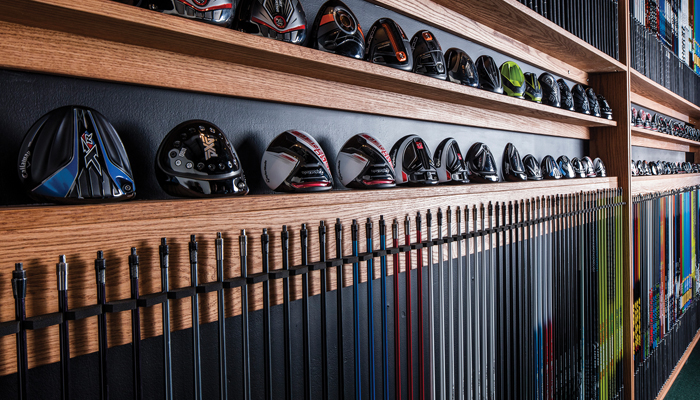
ADJUSTABLE DRIVERS
Todd Swallow & Brett Wright • The Club Fix
The beauty of adjustable heads is it gives the player (and the fitter) the ability to grow into a club instead of having to buy a new one if their needs change. Even 15 years ago, you couldn’t just add loft if you wanted to carry the ball a bit farther, or swap out a new shaft in 10 seconds; putting lead tape on a club was about the extent of “customization” you could do once the club was built.
When you are adjusting your driver (or any club), you are either adjusting the center of gravity, the loft, the lie or adding weight to the toe or heel of the club, or a combination of any of those things.
On raising and lowering ball flight … Moving weight toward the front or back of your driver alters the center of gravity in the club, and, as a result, the spin and ball flight. If you move weight to the back of your driver (away from the face), you lower the center of gravity, promoting a bigger sweet spot, higher launch and more spin. The opposite occurs if you move the weight forward.
The draw and fade bias … Moving weight to the heel of your driver promotes a draw. As the club comes through impact, the toe of the club is lighter than the heel, allowing the clubface to close easier. If you move weight to the toe, the opposite will occur, and the heel comes through impact quicker, keeping the clubface more open.
Driver adjustments are to fine-tune a club to the player, not cover up massive swing flaws. Moving weight to the heel isn’t going to fix your 30-yard slice.
Adding degrees of loft promotes a higher ball flight and more spin, reducing loft produces a lower ball flight and less spin. BUT REMEMBER, adjusting loft also adjusts the lie. If your driver only allows for loft adjustment, when you add loft, you close the face; when you de-loft, you open the face. If your drive has a two-ring adapter (such as Titleist and Callaway), you can adjust loft and lie independently, without one affecting the other.
More distance and lower spin are in high demand, but be careful when adjusting your driver – your swing speed or swing type may be better suited for a “higher-spinning” setup with your driver and may equal more overall distance.
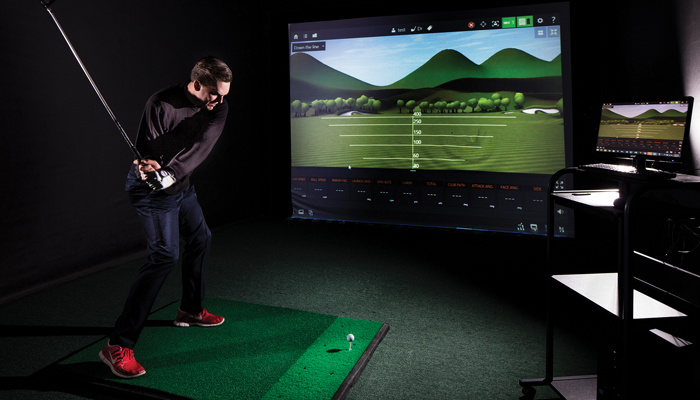
UNDERSTANDING LAUNCH MONITORS
Bo Hodnett • Golf Tech
A launch monitor – such as TrackMan or Foresight or FlightScope – is a device that uses cameras and radar/Doppler technology to track your entire swing, producing accurate performance parameters including ball speed, spin, launch angle, clubhead speed, and uses those parameters to calculate distance and accuracy of a shot.
When using a launch monitor for fitting, the most important numbers to be aware of are swing speed, ball speed, launch angle and spin rate. To get a baseline, we start with swing speed data, which guides us to a shaft stiffness range, and then we can start fine-tuning shafts and heads.
Launch angle is the angle at which the golf ball leaves the clubface, relative to the ground. Launch angle will usually not match club loft, due to the swing path/strike either being descending or ascending.
Spin and launch are important partners … The relationship between spin rate and launch angle is the most important data point to understand when using a launch monitor. The relationship is an inverse one for performance – the lower the launch angle, the more spin needed to get the ball into the air (and keep it there).
“Optimized Numbers” are the ideal numbers for launch and spin at a given swing speed to produce the most distance. These numbers are often more of a hindrance than a help to people, however, because the individual swing path/plane can cause wide variances in launch angle.
Spin equals lift. It’s a simple concept to understand, yet people seem to forget it in the quest to achieve the lowest spin possible. If you utilize an extremely low-spin shaft or head, but aren’t able to launch the ball high enough (due to swing plane), the ball won’t carry far enough and you will lose distance, even with low spin.
Smash factor is ball speed divided by club speed, and is used to determine the efficiency of impact. The higher the smash factor (1.5 is thought to be the perfect smash factor for a driver), the more efficiently all the other numbers (club speed, ball speed, spin, launch angle, etc.) are working together.

FITTING NOVICE PLAYERS
Steve Russell • Leonard Golf Links
You don’t have to be an experienced player to benefit from a club fitting; in fact, a novice player may benefit more. And the bottom line is, everyone wants to shoot lower scores, which is the ultimate goal of any fitting.
On educating new golfers … A fitting for a beginner is also a learning experience. We want the player to walk away with the correct clubs, but also the knowledge to understand their basic needs when it comes to length, flex, loft and lie. We may go old school with an inexperienced player and start super-basic with a static fitting – measuring their height, arm length, flexibility, etc. – and then get them on a lie board to show them visually what they need.
On where to start ... I want to cast a wide net with a beginner – start with large collections of club heads and shafts and work slowly through them. A novice player may not know what they like (as an experienced player would), so we expose them to everything.
The shaft is the biggest piece of the puzzle with the beginner, and where we can help them improve the fastest. The subtle nuances of the actual head don’t matter nearly as much – if they like the way is looks, it’s usually a winner.
Seeing is believing with an inexperienced player. We may do most or all the fitting outside so that the player can see the ball fly and see the improvement. We don’t worry so much about specific data points, because they can overwhelm a new golfer. If the ball goes straight and high, they will be happy.
On hybrids vs. long irons … Set makeup is critical for a player just starting out. Many think they can come in and hit a 4- or 3- or 2-iron, but we recommend nothing higher than a 5- or 6-iron, with hybrid clubs filling in the rest of the set. It can be hard to reign in the ego, but usually when a player can see their ball flight with the hybrids, they change their tune.



